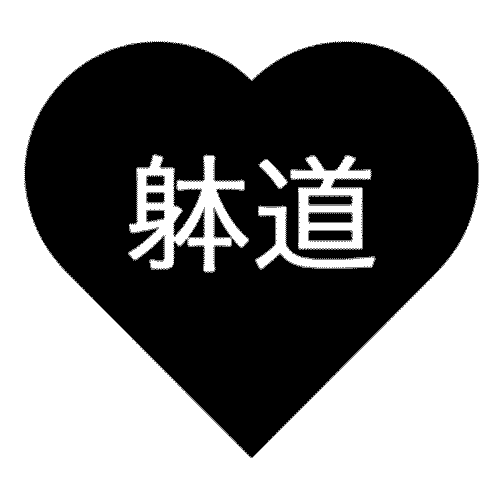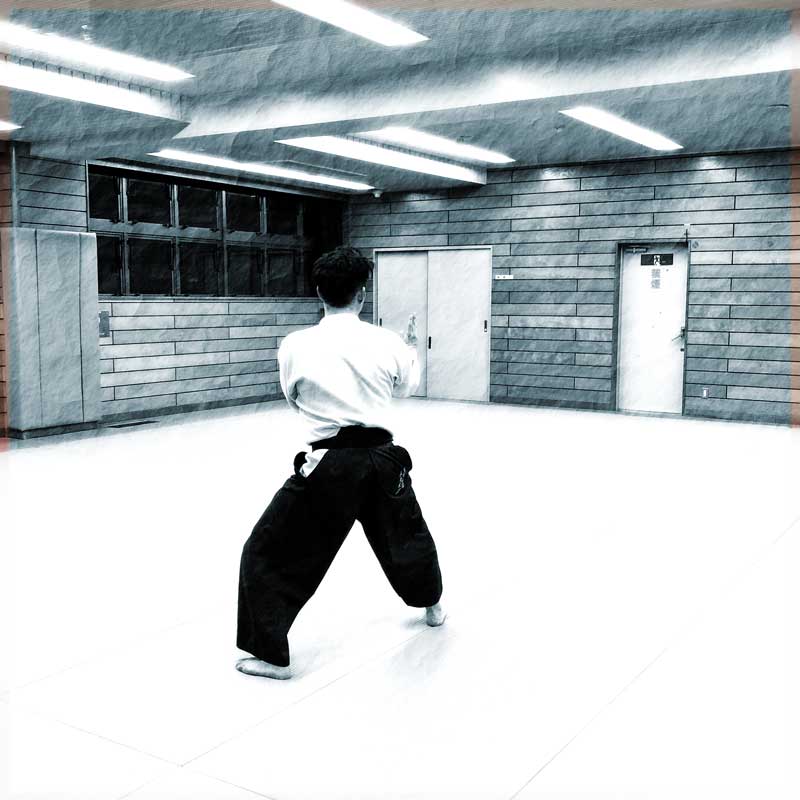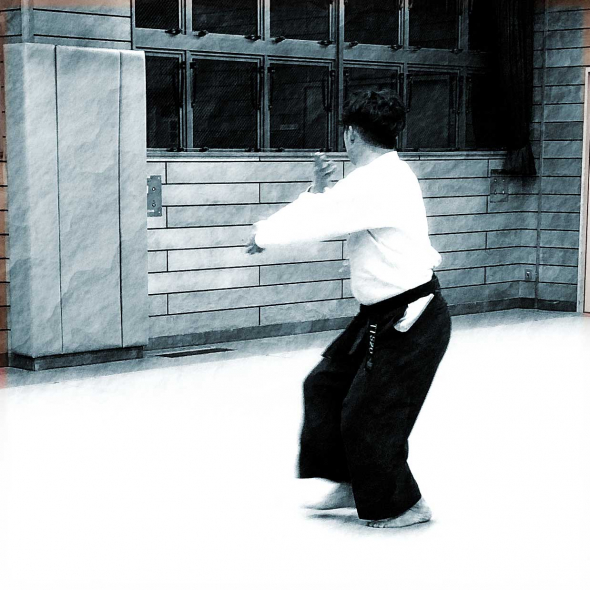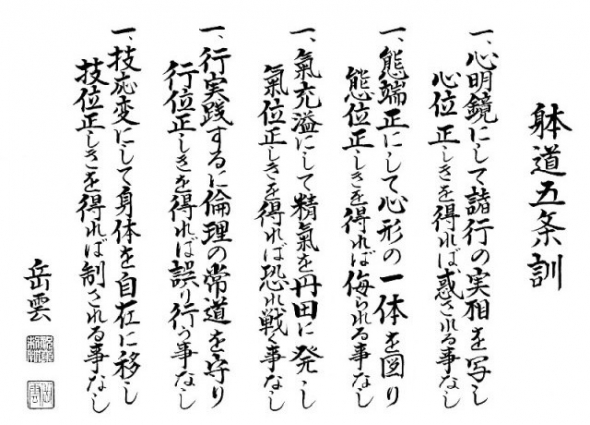Note: This glossary could be better, and I'm working on it... :)
These definitions aren’t meant for absolute accuracy; They are intended to be useful and economical for students to understand the vocabulary they encounter while practicing Taido. As such, some definitions may be unsatisfying to more-experienced practitioners. These definitions are purposefully incomplete because they are meant for use as a quick reference.
I have neglected to include any kind of pronunciation guide, though my romanization from the Japanese terms is fairly self-consistent. The reason for this is that I don’t believe one can learn how to pronounce another language properly without actually learning the basic grammar and usage of that language. For our uses as Taido students, these terms are simply jargon, and mispronunciation is forgivable. However, please don’t go trying to sound smart by using Japanese words when you don’t understand them fully.
Perhaps I will address the efficacy of using Japanese terminology in an English-speaking practice environment elsewhere. For the time being, it is enough to note that Taido remains a “Japanese martial art,” and as such requires the adoption of certain terminology.
If you notice any glaring inaccuracies or omissions, I would really appreciate it if you could drop me a line. Thanks.
Anyway, I hope this helps:
A
Age
Rising, Upward
Age Uke
Rising Block
Aisatsu
Greeting
Aka
Red
Arigato Gozaimasu
Thank you (polite)
Ashi
Leg or foot
Ashi Harai
Leg sweep, also “ashibarai”
Ashigarami
Leg-entanglement technique, usually performed by scissoring at the knee.
Ashikubi
Ankle
Atama
Head
Ate
Strike, essentially any impact-prooducing blow that is neither a punch or kick.
Atemi
Strikes, including punches and other blows
Atemi Waza
Class of all striking techniques
B
Bakuchu
Back Flip
Bakuchu Keri
Back flip kick, also “bakuchugeri”
Bakuten
Back Handspring
Budo
Generic term for Japanese martial arts or combat sports
Bujutsu
Applied martial science and technique
Bunkai
Practice by breaking into Parts. Bunkai practice is the method by which detailed and often hidden technical applications are brought out of forms.
Bushido
The “way of the warrior,” a romantic idealization of the ethics the Japanese pre-industrial warrior class.
C
Chakugan
Eye contact, using the eyes to notice the presence and actions of an opponent.
Chokujo
Straight, direct, moving in a straight line
Chudan
Middle level
Chudan Kamae
Middle level stance, also “chudangamae.” The primary stance for moving in unsoku.
Chui
Warning, typically the first warning given in jissen, but also any general warning
Chuo
Center, command to return to the starting point in jissen
D
Dan
The 10 ranks of black belt level
Do
Way or road, suffix used for all japanese cultural traditions including flower arranging, tea ceremony, and martial arts
Dogarami
Entanglement technique at the waist. Similar to ashigarami.
Dogi
Uniform. Taido’s uniform includes uwagi (jacket), hakama (pleated over-pants), and obi (belt).
Dohai
Another student at your same level or age
Dojo
Training location
Doko
Conditions of movement. Taido’s doko include the principles of how to perform techniques and move the body.
Doko Go Kai
Five rules which guide the execution of each of Taido’s five techniques.
E
Ebigeri
Shrimp kick
Eji
Kneeling position, stance in the shape of the Japanese letter “E”
Ejizuki
Kneeling Punch
Enpi
Elbow strike, also “empi”
Enshogeri
Technically, any kick that strikes with the back of the heel. In America, this generally refers to an upright spinning heel kick.
F
Fudo
Unmoving
Fudodachi
Side stance with feet pointed slightly out and even weight distribution
Fudozuki
Punch from Fudodachi
Fujo
Downward-facing position
Fujogeri
Flying, downward-facing kick
Fukuteki
Dodging technique, evasion by changing the body’s axis
G
Gaiko
Outer condition, the visible body and it’s effects (power, speed, movement)
Gedan
Lower level
Gedan Kamae
Lower-level stance, also “gedangamae”
Gedanbarai
Low parry
Gen-Soku
Unsoku for retreating from an attack, also “gen”
Gensei Ryu
Shukumine Saiko Shihan’s school of Karate which predates Taido by about ten years
Gentai
Returning to genten, or some other safe position after striking
Genten
Original point
Go
5
Go Dan Uke
Five blocks
Go Joukun
Taido’s five principles
Godan
Fifth degree black belt
Gyaku
Reverse
Gyaku Ashidori
Technique for grabbing an opponent’s kick
Gyaku Tedori
Technique for grabbing an opponent’s punch
Gyakuzuki
Reverse punch
H
Hachi
8
Hachidan
Eighth degree black belt
Haimendori
Grabbing the opponent’s body at the waist or back
Hajime
Begin
Hakama
Traditional wide black pants. Taido’s hakama are much narrower than traditional hakama (to facilitate active unsoku) and are used to hold the uwagi (jacket) in place during unshin and tengi.
Hangetsu Ate
Half-Moon Kick
Hanshi
A title for master instructors at or above 8Dan
Hantai
Opposite
Hantei O Torimasu
Call by tournament judges to display the score
Harai
Sweep or parry, also “barai”
Harai Kuzushi
Sweep takedown
Hayaku
Hurry up
Hengi
Changing, transforming technique. Involves changing the body’s axis in order to evade an oncoming attack and counter simultaneously.
Henin No Hokei
Form practice for Hengi (female version)
Hensoku
Irregular footwork
Hensoku Ka
Irregular advancing step
Hensoku Gen
Irregular retreating step
Hentai
Category containing all hengi
Hentai No Hokei
Form practice for Hengi
Hidari
Left
Hien
Flying
Hienzuki
Flying or jumping punch
Hiji
Elbow
Hiza
Knee
Hokei
Form practice. Similar to Karate’s kata, but usually longer. Taido has several categories of hokei for practicing various types of movement, breathing, and strategy.
Honte
Leading hand in kamae
I
Ichi
1
Ido
Moving
Ido Tanren
moving practice. In America, a practice routine for combining unsoku and technique.
In
Negative polarity, similar to Chinese “yin,” of yin & yang. Refers to passivity or defense.
In-Soku
Unsoku for pulling away from the opponent, also “in”
Ippon
Full point
Irimi
Entering the opponent’s space.
J
Jikan
Time
Jikan Desu
Announcement in tournaments that the allotted time has expired
Jissen
Free sparring, Taido’s game of improvised attack and defense
Jodan
Upper Level
Jodan Kamae
Upper-level kamae, also “jodangamae”
Jogai
Out of bounds
Ju
10
Jun
In sequence, keeping with the flow
K
Ka-Soku
Unsoku for advancing toward the opponent at an angle, also “ka”
Kaeshigeri
Returning kick, ssually as a reverse shajogeri
Kaicho
President
Kaijo
Turning
Kaijogeri
A turning kick, Taido’s version of mawashigeri or roundhouse
Kaiten
Rolling or tumbling
Kamae
Way to stand, also “gamae”
Kansetsu Waza
Joint techniques
Karami
Entanglement, scissoring technique
Kata
Shoulder
Keiko
Period of practice or study
Keiko O Owarimasu
Class is over
Keikoku
Second warning in jissen
Keri
Kick, also “geri”
Kesageri
Flying side kick
Ki
Energy, attention, or feeling
Ki O Tsuke
Pay attention, stand straight
Kiai
A shout used to focus the breath and intention along with a decisive technique
Kidosen
Steady line. The line along which techniques are performed
Kidoten
Steady point. Point of origin about which stationary techniques are performed
Kihon
Basic
Kihongi
Basic techniques
Kime
Focus or decision, often in reference to “clean” or “sharp” technique
Kimegi
Finishing technique
Kintama
Groin (male)
Kinteki
Any attack toward the groin
Ko-Soku
Unsoku for changing the angle to the opponent, also “ko”
Kobo
Prearranged offense/defense practice
Kogeki
Attacker or attacking technique
Kohai
Junior student
Koka Sokuto Keri
Dropped side kick
Kokutsu Dachi
Back-weighted stance, Taido’s chudangamae is kokutsudachi
Kokyu
Breath
Kokyu Ho
Breathing methods
Koten
Back roll
Ku
9
Kubi
Neck
Kubigarami
Neck scissoring technique
Kuro Obi
Black belt
Kuzushi
Pull down, any technique that upsets the opponent’s balance
Kyo
Chance to attack
Kyoshi
Title for instructors at or above 6dan
Kyu
The levels before black belt level, also known as the rainbow belts
Kyuchu
Flying, in-air
M
Maai
Engagement distance, also “mawai”
Mae
Front
Maegeri
Front Kick
Makiwara
A wrapped target for training the mechanics of various strikes
Manji
Japanese swastika. Good luck symbol used to denote temples on Japanese maps.
Manjigeri
Kick in the shape of the Japanese letter “Man”
Mawashi
Going around
Mawashigeri
Turning kick, roundhouse kick
Migi
Right
Mikazukigeri
Crescent kick
Minete
Ridge hand strike, making contact with the ridge of the hand running along the index finger to the thumb
Modote
Return
Moichido
One more time
Mokuso
Meditation
Morote
Both hands
Morote Gedan
Kokutsu stance in which both hands are held low
Muko Maai
Ineffective distance, distance in which neither opponent can execute strikes
N
Nage
Throw
Nage Kuzushi
Throwing takedown
Nage Waza
Throwing techniques
Naiko
Inner condition, the effect of techniques on the body’s organs and nerves
Nana
7
Nanadan
Seventh degree black belt
Neko Ashi Dachi
Cat foot stance
Nenchu
Twisting flip
Nengi
Inverted, twisting technique
Nenin No Hokei
Form practice for Nengi (female version)
Nentai
One of the five types of technique including all Nengi
Nentai No Hokei
Form practice for Nengi
Nentaigeri
Horizontal twisting kick
Ni
2
Ni No Ashi
Leading step
Nidan
Second degree black belt
Nidangeri
Two-level front kick, double kick
Nidanzuki
Two-Level punch
Nukite
Spear hand, striking with the tips of the fingers
O
Otagai Ni Rei
Bow to each other
Obi
Belt
Oizuki
Stepping punch
Onegai Shimasu
Request for a favor or assistance
Oshi
Push
Oshi Kuzushi
Pushing takedown
Ossu
Affirmative reply, greeting, notorious “karate word”
Oten
Side roll, shoulder roll
R
Rei
Bow
Rendo
Moving continuously
Renshi
A title for instructors at 4dan or 5dan
Renshu
Practice
Roku
6
Rokudan
Sixth begree black belt
S
Saiko Shihan
Supreme instructor
San
3
Sandan
Third degree black belt
Sandanzuki
Three-level punch
Seigyo
Control over the situation/opponent
Seiho
Method of applying control
Seiretsu
Make a straight line
Seiza
Formal sitting posture
Sengi
Whirling, spinning technique
Senin No Hokei
Form practice for Sengi (female version)
Senjo
Spinning
Senjogeri
Spinning kick
Senpai
Senior student, also “sempai”
Sensei
Teacher
Sensei Gata
Group of instructors
Sentai
Class of all Sengi, spinning techniques
Sentai Nirendo
Two continuous sentai punches
Sentai No Hokei
Form practice for Sengi
Sentai No Tsuki
Spinning punch
Sentai Nukite
Spinning spear hand strike
Shajo
Angular body, diagonal posture
Shajogeri
Kick angled up from the ground
Shazenten
Angular roll, shoulder roll
Shi
4
Shi Ho
Four steps, four directions
Shiai
Contest
Shichi
7
Shichi Gen San Ka
70% back, 30% front weight distribution in chudangamae
Shihan
Title for high-level instructors, typically above 6dan
Shihandai
Secondary dojo leader
Shikoku
Third warning in jissen, disqualification
Shin Karatedo Kyohan
Shukumine Saiko Shihan’s book Genseiryu karate. Includes descriptions of tactics, techniques, and kata.
Shin Untai No Hokei
American name for the newer wersion of Untai No Hokei practiced in most countries
Shinpan
Judge
Shinsa
Examination, test for belt/rank promotion
Shiro
White
Shitsurei Shimasu
Excuse me
Shobu Ippon
One-point match
Shodan
“Beginner,” first degree black belt
Shomen
Front
Shomengeri
Maegeri
Shotei
Palm heel
Shoteibarai
Parry with palm heel
Shuto
Knife hand, bottom edge of the hand
Shuto Ate
Knife hand strike, “karate chop”
So-Soku
Unsoku for pushing toward the opponent, also “so”
Soete
Covering hand in kamae
Sokuchu
No-hand cartwheel
Sokuten
Fast cartwheel
Sokuten No Tsuki
Cartwheel punch
Sokutengeri
Cartwheel kick
Sotai
Tactical movement, kobo or jissen, the five methods of body movement
Soto
Outside, outward
Soto Uke
Outside middle block
Suihei
Horizontal
Suiheigeri
Horizontal kick, Taido’s version of the side kick
Suki
An opening to be attacked, weakness
T
Tachi
Standing, a way of standing
Tachirei
Standing bow
Taii No Hokei
Hokei designed for the transition from Gensei Ryu to Taido
Tai-Soku
Unsoku for returning to Genten, also “tai”
Taido Gairon
Shukumine Saiko Shihan’s book describing the principles and methods of Taido
Taidoka
Practitioner of Taido
Taijiku
Body axis, centerline
Taikai
Competition
Taiki
Body energy, breathing
Taimen Sankatsu
Three divisions of the body
Tatami
Straw floor mat, often covered in vinyl
Tatte
Stand up
Te
Hand
Tekubi
Wrist
Ten-Soku
Unsoku for adjusting the angle about a point, also “ten”
Tengi
Tumbling technique
Tenin No Hokei
Form practice for Tengi (female version)
Tentai
Class of gymnastic techniques, tengi
Tentai No Hokei
Form practice for Tengi
Tobi
Flying, jumping
Tobigeri
Jumping kick
Tobikomi
Diving
Tooite
Relax
Tori
Pull
Torite
Block and pull the opponent’s punch
Tsui-Soku
Unsoku for quickly punching, also “tsui”
Tsuki
Punch, also “zuki”
U
Uchi
Inside
Uchi
Routine
Uchi Uke
Inside middle block
Ude
Arm
Uke
Block
Ukemi
Falling techniques, breakfalls
Undo
Exercise
Ungi
Moving, working technique
Unshin
Movement using the whole body, locomotion other than stepping
Unsoku
Footwork
Unsoku Gorendo
Routine of five continuous Unsoku patterns
Unsoku Happo
Routine of 8 footworks
Untai
Set of all Ungi, techniques in characterized by vertical displacement
Untai Hienzuki
Jumping or punch
Untai Keri Tsuki
Untai kick and punch
Untai No Hokei
Form practice for Ungi
Untai No Tsuki
Basic Untai punch
Ura
Behind
Uraken
Backfist
Ushiro
Back, rear
Ushirogeri
Back kick
W
Waza
Technique
Waza Ari
1/2 Point
Y
Yame
Stop
Yo
Positive polarity, Chinese “yang,” active, aggressive attitude
Yoi
Ready
Yoko
Side
Yokogeri
Side kick
Yon
4
Yondan
4Th degree black belt
Yuko Maai
Effective distance
Z
Zarei
Seated bow
Zenchu
Front flip
Zenkutsudachi
Forward stance in which most of the weight is carried by the front leg
Zenpo
Forward
Zenten No Tsuki
Front roll punch
Zokko
Command in jissen to continue the match



